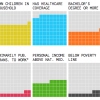The Importance of Color in Data Design
Let’s talk about color.
How important are colors in data visualisation design? A science and art unto itself, colors play a major part in how information is being conveyed and received by the human brain. Study shows that color, as part of the electromagnetic spectrum, is in its purest form a wavelength energy with its own magnetic frequency. This frequency thus creates biochemical responses in the brain. Sounds crazy, hey? How fascinating is science!
From the point of view of art and design, the wrong choice of colors can make or break the design. Why? It’s because colors speak volumes on their own, without needing any words. Each color represents something — a deeper meaning, if you will, that is understood by the human psyche as soon as the wavelengths transmitted are reflected back to our eyes.
Color Meanings
The meanings of colors could either be an emotion or a concept and were built through years and years of color association. There’s a lot more to it though! The diagram above represents the most common color associations in the West. Some colors are perceived as completely different through the lens of different cultures.
Take the color red, for instance. In China, red is associated with prosperity, happiness and good luck, which is why red decorations and clothing are adorned all-over during Chinese New Year. In Africa, red has become the color associated with AIDS awareness due to the popularity of the RED Campaign.
There are also the factors of hue (think shade) of said color and how it is used in contrast to other colors. A slight change in hue may evoke different emotions in the viewer or result in different color meaning. High contrast between two colors creates a shocking effect, whereas the eyes will dart to the more dominant color. For illustration purposes, let’s look at some examples below…
In this iconic artwork, Barbara Kruger uses a vibrant red in contrast to monochromatic colors to draw attention to the copy printed in red.
Startup Lab utilises a muted red to evoke energy without being too aggressive.
Knowing the unspoken meaning and the effects of colors on the majority of people is an incredibly valuable knowledge that designers can master and offer to clients. Back to the topic of data viz design, color is super important for various reasons:
- Due to the ‘pre-attentive’ attributes of data visualisation (meaning: first impressions matter), choice of color affects how the audience can grasp the differences in data at first glance.
- Data viz is about communicating information through the positioning/size/shape/transparency of objects — the colors of the objects affect how the audience perceives these traits.
- Good to note that color in data viz is about both contrast and hue. But one must address contrast first before worrying about hue. Remember, contrast is about the differences in two colors, and hue represents the color itself and the shade it is in. But do we know what colors are good next to each other? To have a good insight into this, we have to understand basic color combinations.
Combining Colors
Color combination is crucial in creating designs that are aesthetically pleasing to the eye. To have a comprehensive understanding of colors, let’s look at the color wheel.
Looking at the color wheel, warm colors are the reds, oranges, and yellows. Opposite are the cool colors — the greens, blues and violets. The color wheel is an ample guide to create color combinations that are in harmony with each other. There are several color combinations that data viz designers can refer to, depending on the outcome that is desired.
1. Complementary Colors
Complementary color combinations are two colors that sit opposite each other on the color wheel.
2. Split Complementary Colors
For a combination of three colors, split complementary colors contain two nearing color hues and one that is opposite of them in the color wheel, illustrated by the picture above.
3. Triads and Tetradic Color Combinations
Triads and tetradic color combinations are three/four colors opposite each other determined through geometric shapes.
4. Analogous Colors
Analogous color combinations take colors that are next to each other on the color wheel.
5. Monochromatic Colors
Monochromatic colors are color combinations of the same hue, but containing different tints, tones, and shades.
Despite all this information, there is still a lot more to colors. It is truly a vast and subjective topic, one that some build entire careers on, as color consultants or brand consultants. In terms of data visualisation, the correct color combo chosen plays a crucial role in the way viewers will digest the data.
If you are struggling to contain all this info, don’t fret! There are various free tools that generate color schemes to get you started before doing it on your own.
So there you have it, a primer on colors. If you enjoyed this blog post, then you shall enjoy the Design Principles series that we have cookin’! Keep your eyes peeled for our next one.
Meanwhile, check out some previous posts we have on design:




